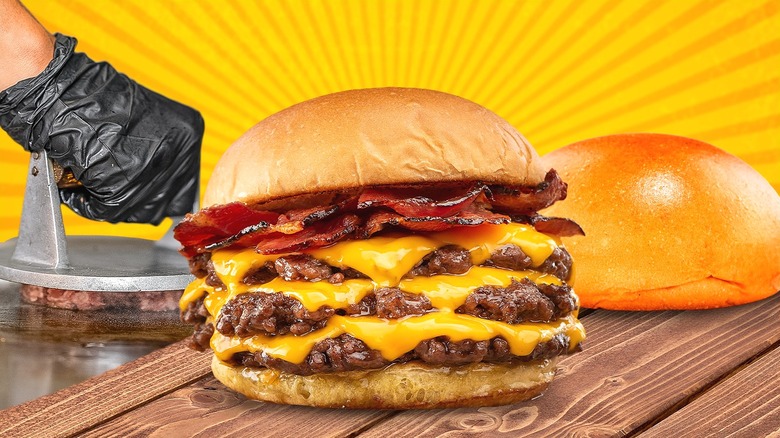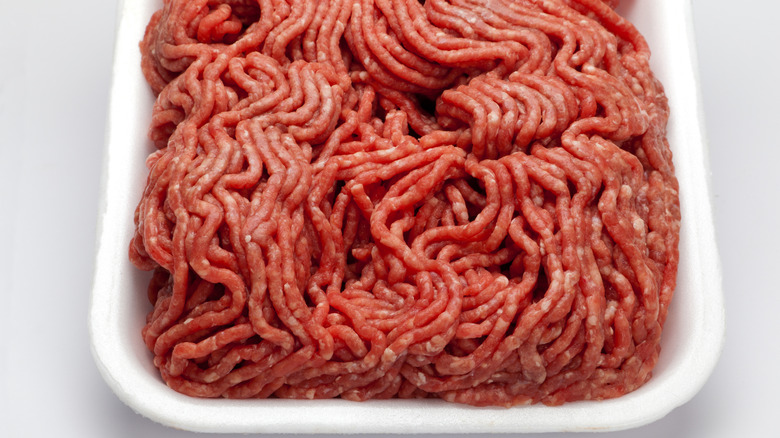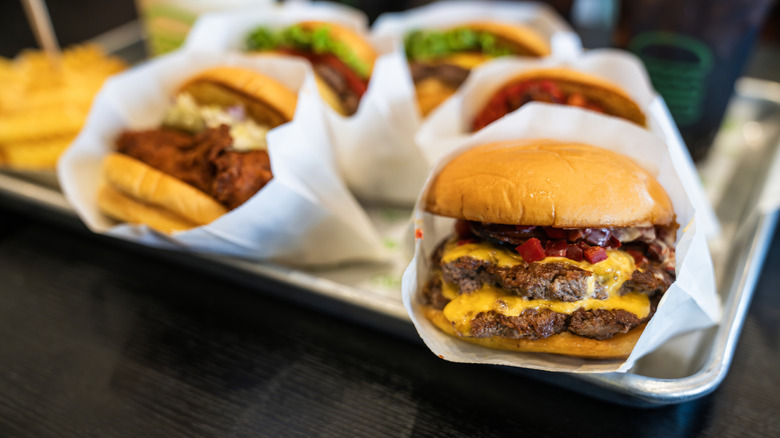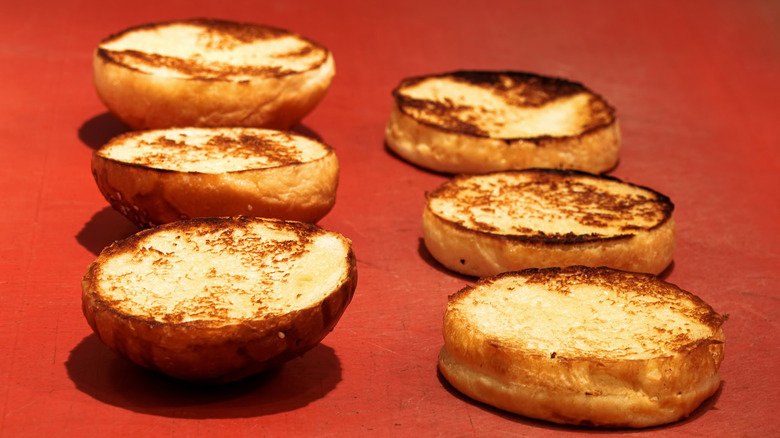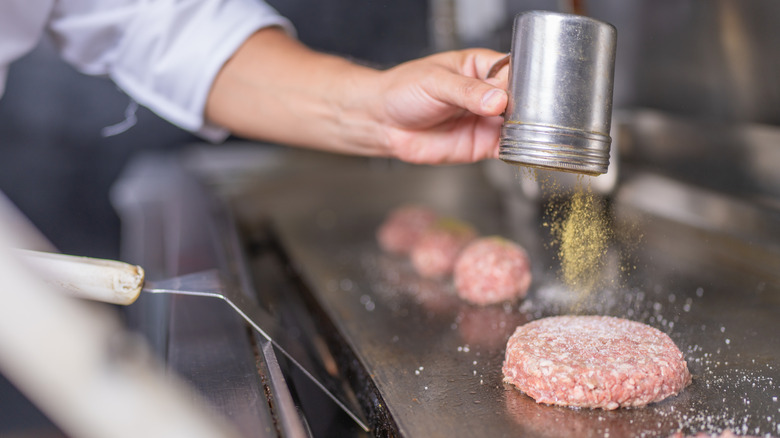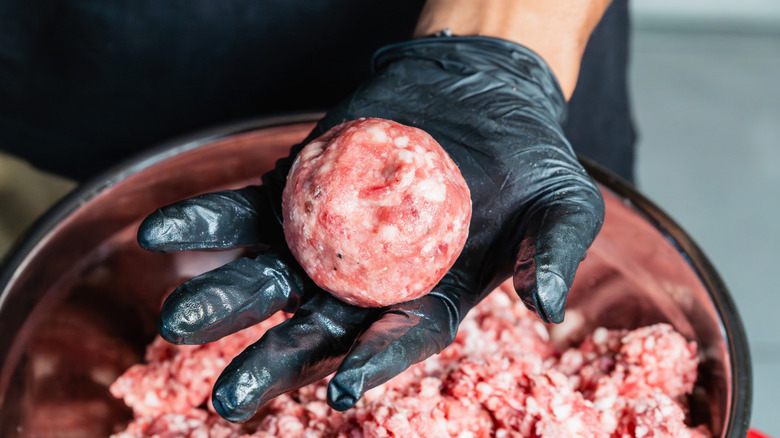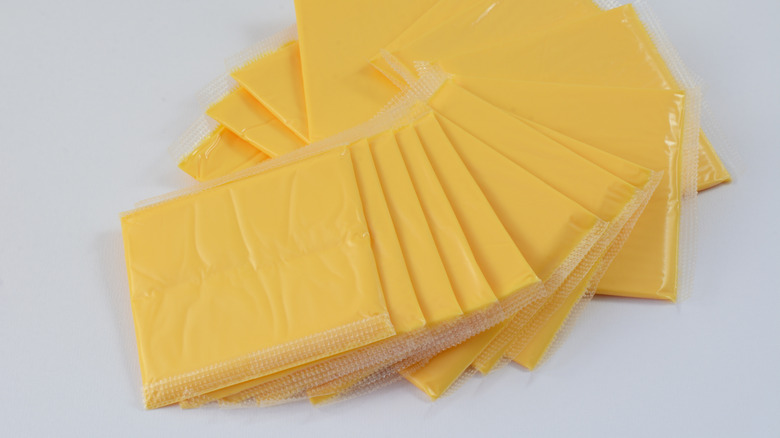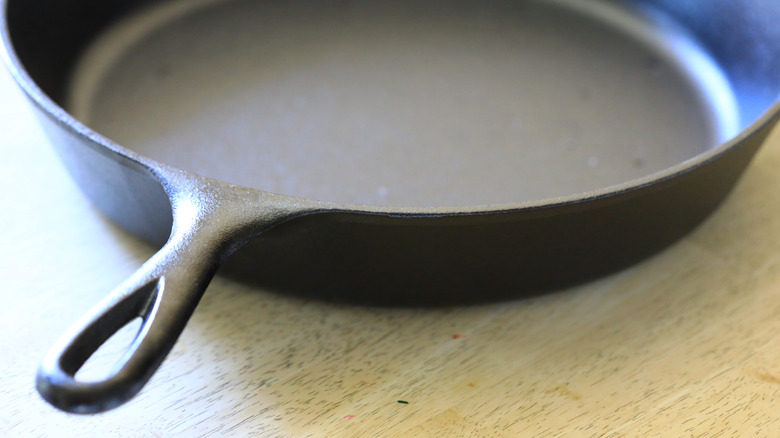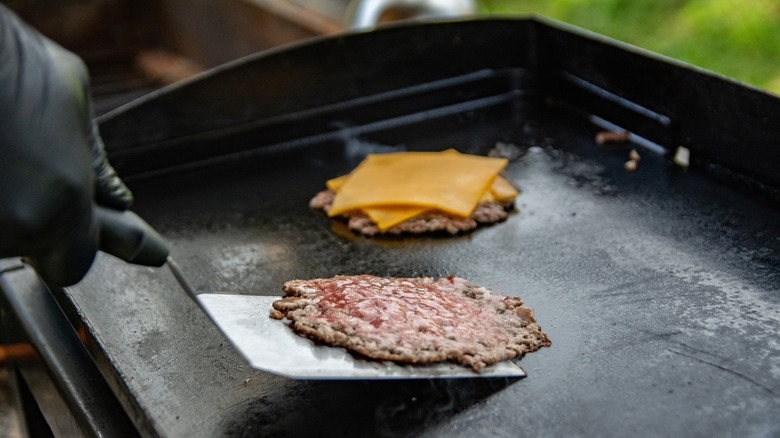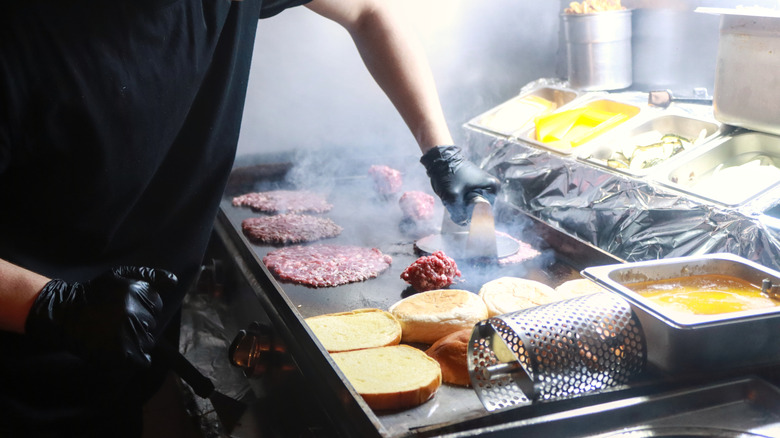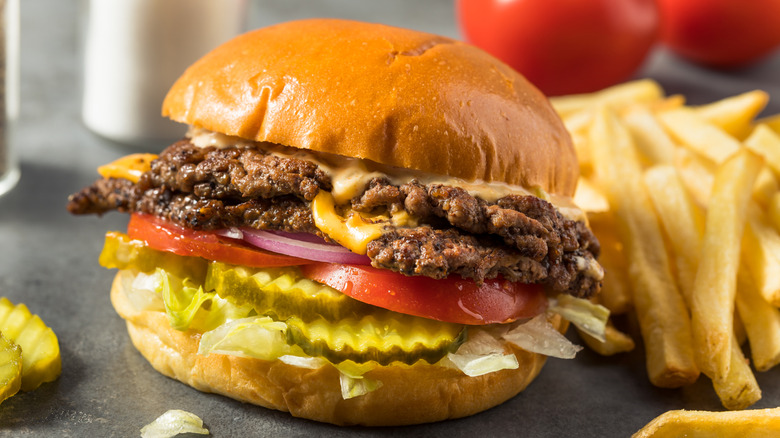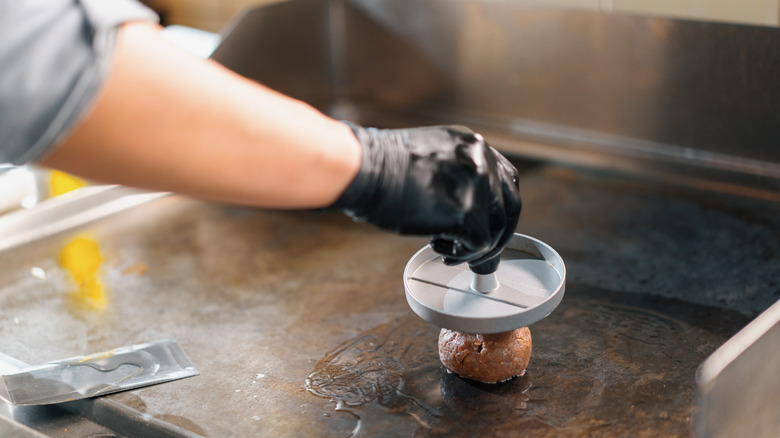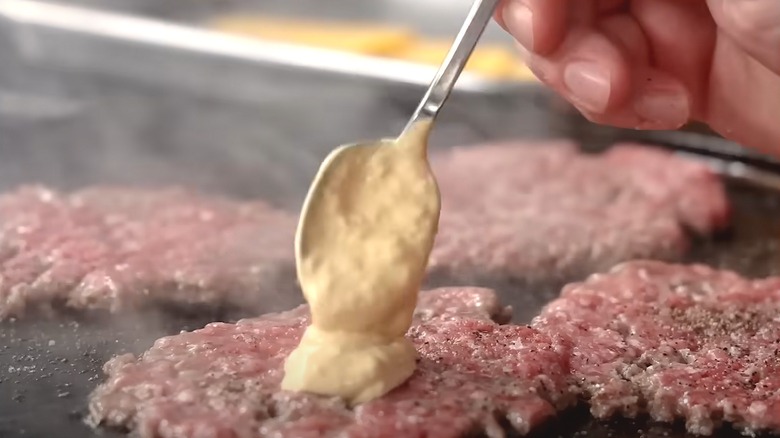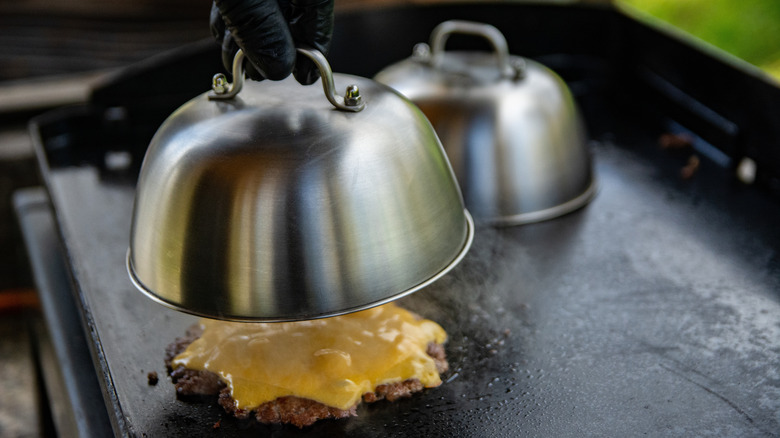13 Delicious Tips For Top-Notch Smash Burgers
America is a hamburger-loving populace. Within the last decade, however, there's been an undeniable shift away from large, jaw-unhinging burgers towards stacks boasting slimmer characteristics — at least among fast-casual chains. Featuring thin beef patties (the result of a Hulk-like smash on a steaming-hot griddle top), smash burgers are delightfully simple and teem with chow-down-able traits. There are numerous styles you'll find on the menu, but typically, restaurants will dress them with the following garnishes: oozing cheese, iceberg lettuce, sliced tomato, and a bright, tangy special sauce. From there, customers can tweak or alter the hamburger to align with their own preferences.
This is also the prime advantage of assembling this drive-thru staple from scratch. By crafting your own version of the beefy classic, nobody can turn down your request to triple the patty, hold the onions if you don't like 'em, or to mix up a condiment that's not just another pale-pink Thousand Island dressing (if you've ever wondered, here's why it's all the same). However, there's a learning curve to nailing the moist juiciness and craggy, crisp texture, so we took it to the professionals to dispense their wisdom grill-side. Here are 13 tips to achieve a top-notch smash burger, courtesy of Billy Kramer of NFA Burger and a spokesperson for Smashburger (who else?).
High-fat beef works best
What beef you choose to purchase, without a doubt, determines the quality of your smash burger. In general, you want your patties to sear to a frizzled finish while maintaining a mouthfeel that's pleasantly tender. To nail these elements well, burger masters say it's best to buy meat with a higher lean-to-fat content, since more fat is guaranteed to hold up to extreme grilling methods that would scorch an 80/20 divide (Gordon Ramsay's go-to combo) by comparison.
The Smashburger spokesperson waxed poetic over 75/25 blend, claiming the beef to be unrivaled in drawing out flavor from the spices. As they explained to Chowhound, "This ratio allows burgers to 'percolate' after they are smashed, melting the seasonings into the burger evenly." This is accurate to Beef. It's What's For Dinner's breakdown on the blend, given that the amount of fat leads to an easier go of sauteing on high. Billy Kramer of the Dunwoody, Georgia, establishment, NFA Burger, encouraged the all-but-identical 73/27 variety ("if you can find it") to deliver a similar consistency. If it wasn't accessible from the freezer section at your grocery store, you could see about tracking down a butcher to grind out a customized blend for you.
A no-frills bun showcases the burger patty
If the tattered-edged patty is the salty star of your smash burger, this is a reminder that the bun should be present, but unable to outright steal its thunder. Now is not the time for an artisanal, mega-sized pretzel roll shimmering in Maldon salt. Staying in character with the humble simplicity of a smash burger, it's definitely recommended that you choose a fairly standard bun in line with diners and backyard cookouts — so is there a specific style you should buy when shopping for the ingredients to bring the drive-thru home to you?
It's true that grocery store hamburger buns vary in terms of quality. However, the key is the consistency, which should mainly be yeast-like and soft. You can easily pick a no-name white bun, but consider how the pros are sandwiching their beef. Billy Kramer of NFA Burger favors old-school potato buns for a deliciously gooey smash burger. It's the perfect shape for a palmful of beef, and the yellow bread is spongy and pliable to the touch, which helps bundle up the stack between your hands. "Buns may be simple, but the wrong bun can ruin a burger," as Kramer notes, so we would avoid choosing something cumbersome or extra large.
Toast the buns to prevent sogginess
You can trace the Maillard reaction to the charred fringe gathered at the sides of your beef, but did you know the feat of chemistry applies to griddling bread as well? If you want to dupe a West Coast style delight from your own backyard, toasting the buns remains an absolute priority. Browning the roll adds an attractive finish to your smash burger both in taste and presentation. Even more to the point, crisping them under high heat functions helps to protect your bun from getting soggy. If you enjoy fillings that tend to be on the moister side — think any Thousand Island-esque sauces or iceberg lettuce — giving your buns a bit of a barrier, so to speak, aids it all from falling apart into a dribbling mess.
For an added twist, heighten the richness by spreading on some butter. The hint of richness compliments the crunch of the bun, all the while leveling up the interior of your handheld that's noticeable, but never too much. Smashburger and Culver's (Andrew Zimmern's favorite fast food burger, by the way) are some of the spots in the U.S. that commit to this optional — though by no means frivolous — embellishment to crafting an even better smash burger.
A unique seasoning blend can add dimension and flavor
Experts will hammer it into your head that a top-notch smash burger doesn't need to be complicated. Fewer embellishments between the bun is a feature of this immensely popular drive-in staple. This isn't to say seasonings don't play a role in heightening the experience; as a matter of fact, chefs like Billy Kramer strongly approve of shoring up a custom-to-you spice mix that speaks to your burger-loving sensibilities.
Incorporate your old faithfuls like salt and pepper, but make sure you don't sit on the possibilities awaiting from your spice rack. Celery salt is the ultimate seasoning addition to take your smash burger to the top — it's like ordinary salt except infused with an earthier kick. You could try a pinch of paprika or cayenne for extra smokiness and heat. Assuming a zesty secret sauce will be in your arsenal, you don't want to drown your meat in a mountain of seasonings.
Kramer suggests shaking on your spice blend toward the end of the cooking process while the beef spits grease on the stove top. "This allows your seasoning to get more surface area," he says, thereby resulting in mouthfuls that are balanced.
Form the beef into loose balls
Starting the smashing isn't going to take place until you take out your spatula and fire up the pan. Therefore, it's not necessary to proactively pound down your meat, even if it seems like it'll save time once you get to cooking. Instead of squashing the patty rounds in advance, you'll want to divide your ground beef, but with a lighter touch. There is a difference: ground meat is full of texture-rich fibers, including the fat, and the point of a smash burger is to crush them thin — really, really thin. Preemptively squishing your meat will cause your patties to dry out once they start to sizzling, and the rationale here is to not squeeze out all those juices prior to hitting the grill-top.
You can tear off chunks of your meat to create segments. For those using a scale, Billy Kramer of NFA Burger claims each burger ball should weigh no more than 3 ounces — and don't apply too much pressure with your hands. Simply divvy them up into loose piles, shaping them into the portions that'll compose your smash burgers without firmly molding them like Play-Doh. Acclaimed butcher Pat LaFrieda stands by this tactic, telling Katie Couric Media it does a better job of unlocking the charred, griddled consistency that makes the drive-thru staple so mouthwatering.
Opt for American cheese
Go to a pub joint, and you'll probably find hamburgers draped in rich slices of Swiss or crumbly Roquefort. Go to In-N-Out, the location of Anthony Bourdain's favorite fast food burger, and you'll encounter gooey, synthetic deliciousness of American cheese. American cheese is heavily processed, and the array of additives (among them potassium citrate) yields a dairy substance that practically melts on command. Another benefit experts adore from this rubbery topper comes down to the taste. Rather than acting as a pungent distraction, American cheese exudes a mild, mellower flavor. This is helpful for bouncing off the burger's robuster sensibilities, particularly in the prominently-tangy garnishes and griddled patty.
Versus cheddar cheese, an equally popular burger topping, a Kraft single is basically engineered to ooze and turn creamy. For any fast-paced dish where you have to act on a dime (case in point: the smash burger), this is essential. Should you crave the humble simplicity of a pounded-down patty, there's no question the classic cheese, through and through, is all-American. As to how many you should add, you're the boss of your cheese, though one slice per patty is probably best.
Use a heavy-duty cooking surface
Of course, building a fabulous smash burger on par with a retro carhop requires having the right equipment. "You need a flat surface to smash a burger," according to Billy Kramer of NFA Burgers, and his appliance of choice for burger-smashing matters is as heavy-duty as it gets. A cast-iron pan works wonders, though any portable skillet, like a griddle, is commendable for the task of smashing, flipping, and churning out patties. This sturdy cookware is prized for its ability to generate (plus endure) higher amounts of heat, and effectively draws out those gritty brown scraps forming the lacy coating.
Not everyone at home will have a grill, but if you already own one it's the go-to appliance the folks at Smashburger swear by for extensive charbroiling. Per the chain's spokesperson, "using a grill is ideal for safety and makes it easier to lift the burger off the surface," making it a pragmatic choice for professional fry cooks. Due to the intensity of the searing, we wouldn't recommend slapping your patties on a non-stick skillet. The Teflon covering the surface is much too slick to get a good crisp, and it'll get easily scratched — and ruined — by your kitchen utensils.
Get ahold of the proper tools
Honing your technique matters a great deal with smashing a burger, so gathering decent tools to obtain those results will make all of the difference. "A heavy, durable spatula works very well," according to NFA Burger's Billy Kramer — especially because it's great for scraping and somersaulting the patties as needed. In contrast, Smashburger's spokesperson hyped the texture-enhancing finesse of a handheld burger press. It can assist in broiling the surfaces of your beef and acquiring an even thinness at all angles (per the chain, about 1/3 inch is preferred). You can't go wrong with either option, and it's these humble instruments that'll produce the searing and smashing definitive of this delicacy.
A solid spatula can help create the salty trim of beef lining your smash burger patty. It's called lacing, as evident by its appearance, and Kramer doled out a trick for ensuring you get it every time: "Once you smash the burger with a spatula, run the flat side of the spatula around the edges of the patty."
Raise the heat to unleash the perfect sear
Once you've portioned the meat and grabbed your trusty Lodge pan, now's the time to kick-start the stove. Make sure you raise the temperature so when the beef meets iron, as the heat will unleash a picture-perfect outer crust. This is the Maillard reaction at work, and it functions a tad bit differently to a similar culinary phenomenon — caramelization. In this case, the protein of the meat enters a round of chemically-inspired alterations, conducting a change in color
Billy Kramer concedes on 350 F as a standard temperature to effectively ignite browning, but for the sake of a consistent sear, he expressed a fondness for 400 F. Per Kramer's reasoning, raising the temp is necessary for the skillet to retain the heat emanating from within. Your meat will most likely be chilled from the refrigerator, and this colder blast that occurs from making contact with the cookware has the disadvantage of slowing the sizzle. Not only does this blunt the broiled layer we crave from a smash burger, but sitting in its juices longer offers the disadvantage of overcooking the beef. Avoid this common burger mistake, and your homemade version will pull all the stops for griddled greatness.
For the toppings, cohesion is crucial
Now that we've covered the foundations of a smash burger, we can start talking about the extras that allow it to sing. A squirt of ketchup, diced onions, tart relish spread — any of these burger toppings would fit the bill for stacked, beef-centric bliss. It's equally important that the accoutrements don't clash when it's time to digging into your handheld. In Billy Kramer's view, "everything on a burger should work together," so it's important to not go entirely overboard loading up your stack with toppings that don't gel naturally.
Are burger maestros simplifying the add-ons or deciding the sky is the limit on peak variety? The Smashburger spokesperson Chowhound spoke with provided many mouthwatering ideas demonstrating either tack works — just make sure you follow the main goal of achieving some semblance of harmony in the options you do decide to play with. Kramer prefers condiments with an acidic edge, such as pickles and mustard, to compliment the charbroiled beef. However, you can also add bacon, grilled chili peppers, or even an herb-infused mayonnaise for pizazz. It really depends on your preferences, but if you're in need of additional wisdom, Anthony Bourdain's one-hand rule is pretty reliable for guiding your burger journey.
Work quickly to smash your burger
Fry cooks, assemble! The cooking process may be simple, but each move must be intentional. Because you're cooking with high heat and a lot of grease, your smash burger can scorch or shrivel easily. When the oiled pan starts shimmering, toss on the meat ball, squash it down, watch for the edges to singe, and then flip. Altogether, the ordeal can take only a few minutes to actually see through until the hamburger is on your plate, ready to go.
Something to look out for, from what our experts know about cooking burgers (hint: a lot), is timing things right. Billy Kramer, for example, attests to having your pan already heated prior to throwing your beef onto the stove. Once it's sizzle time, crush it down in half a minute. As he reasoned, "The longer the meat is on the grill, the quicker the fat renders and you don't want to lose too much fat." Considering Smashburger's spokesperson gave a 90-second estimate between the first flip and second, preparing yourself for split-second decision-making certainly pays off in the end.
Sear your patties with a delicious sauce
For a bonus burst of flavor, you can't go wrong with adding more sauce. We don't mean dressing the buttered bun with a generous smear — we mean searing it into your patty. When you've flipped the hamburger patty once, go ahead and spoon your favorite condiment onto the middle of your hamburger round (just a dab will do it). Saturating the thin scraps of meat, the garnish works two-fold in increasing the moisture — a must for browned burgers — while infusing a little extra oomph.
The trick we're speaking of is a little unconventional, yet totally spot-on if you want to maximize the experience during your next summertime cookout. In fact, it's right out of the pages of In-N-Out's rule book. In the case of the California chain, one of its secret menu hacks is ordering your burger grilled in mustard. Thousand Island dressing delivers an equally punchy zing your guests will rave about.
The power of steam yields oozing cheese
Having already established the dissolubility of American singles, it's still possible to render a creamier result on your smash burger than expected. The trick is pretty simple — just add steam. A common technique burger flippers employ is cloaking their patty with cheese before placing a lid on top to coax the melting even further. From the trapped heat, the cheese soaks in all of the meaty vapors, consolidating the flavors while triggering a heftier free-flow of tangy yellow goodness.
Be sure and follow Billy Kramer's instruction for foolproof oozing to increase the wow-factor of your burger. "Once you flip, place the cheese on the patty and then cover to get a proper cheese melt," he says. To add on to that advice, Smashburger's spokesperson suggests immediately removing the patties from the skillet upon steaming the cheese. That way, every mouthful will be positively gooey — not chewy from shrinking or dehydrating from lingering in the skillet a touch too long. Dig in for yourself to see why it's worth the brief pause.
